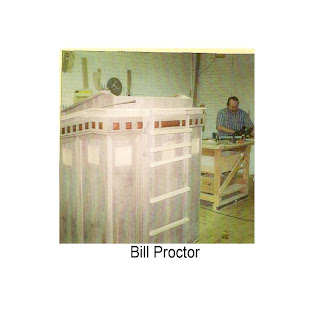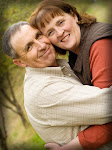It was in the New Utah Newspaper April 5th, 2000 Volume 22 No. 14
Something to stand before: AF woodworker Bill Proctor helped to build pulpit at LDS Church's new Conference Center
By Barbara Christiansen
AMERICAN FORK -
When LDS Church president Gordon B. Hinckley planted his now-famous walnut tree in his yard, American Fork's Bill Proctor was only three years old.
Now the two have met and have spent a lot of time together. Proctor was one of the major craftsmen who took wood from Hinckley's walnut tree and created the pulpit which now graces the church's new conference center.
During the Saturday morning session of General Conference when President Hinckley spoke about his walnut tree and how it was made into another object of beauty, the experience brought tears to his eyes.
It also touched Proctor, who spent most of the last month of his life creating that pulpit.
"I started to cry right along with him." he said. "It was pretty awesome to be able to do it."
As beuiful as the wood work on the pulpit looks on television, it is that much more amazing in person.
"The TV really doesn't do it justice," said Proctor. "It looks brown, but on the top you can see the grain. It is called feather crotch because it is taken from the joint of the tree branches."
Original arcitectural drawings of the pulpit indicated a more modern approach, with a Millennial Star pattern on the sides, but church officials wanted to continue the behive, bases on the pulpit at the Tabernacle.
They again turned to Proctor, who is also a beekeeper.
"It was neat to be able to bring my two loves together," he said.
In the background of each square with the beehive motif, there is a honeycomb pattern. That was taken from actual honeycombs, from one of Proctor's 70 hives in the Wallsburg/Heber area. Workers placed ink on the honeycomb and created the pattern. It was then reprduced with a CNC router, with each one taking approximately 50 minutes.
Proctor has one of the honeycomb patterns and frames at his home, along with a beehive he carved himself to recreate the hives from the pulpit.
American Fork's Cole dalton was also intensely involved in the project, serving as detailer, making the drawings of the project. Both men work for Fetzers,Inc. of Salt Lake City.
During the process, President Hinckley visited and inspected the progress. Once he asked Proctor if he would like to be the frist one to deliver a sermon from the pulpit.
""Thats's OK,' I replied, 'I will leave that up to you,"" Proctor responded.
Design of the pulpit is quite complicated, with 77 different types of pieces involved, many of which have multiples. The company had a weight limit of 500 pounds, and the finished product weighted in at 493 pounds.
Many of the items included in the project do not show up to the general public, such as the fans which are placed to cool the speakers. There will also be a television monitor included.
There are other items no one else can see, but the workers and others know they are there.
For example, sandwiched between some pieces of wood on the front of the pulpit are written names of proctor's family members. When he mentioned that to some of the members of the LDS ward, he was asked to include other names. To satisfy the requests, he simply added "American Fork Third Ward." Proctor noted the practice has been common through the years, and the pioneers who built the tabernacle also signed their work.
The experience was one of Proctor's most satisfying.
"I have done wood working on all different kinds of projects." he said. "we built a large conference table for sony in California, and done projects which went to Russia, back East, to the Mall of America.
But none of those jobs comes close to this one in my eyes."
He has worked on other projects for the LDS Church, including other areas of the conference center. They constructed the six biggest towers for organ pipes, which added to create some distraction for Proctor as he watched the Saturday conference sissions on television.
"I had to put on my earphones to make myself concentrate and not be distracted be seeing our work," he said
Proctor noted the construction went just about as smoothly as could be.
" They actually allowed me to take my time with it." he said. "They told me to do whatever it takes, but do the job right. Through the whole process, we took probably about one month. That is really quite a while for a project."
As Hinckley recounted in his conference address, the wood from his tree was a limited resource.
"We had no stockpile of wood," said Proctor. "we had to really make sure the work was precise and accurate."
He normally doesn't get to follow the process through from start to finish, but in this cas was able to do just that.
"T took it right from the board to slicing it up into the different pieces," he said ."We sliced the pieces quite thin and glued them onto another piece to get it to match just right."
Wood to create the beehives to decorate the sides was made of cherry, not the walnut of Hinckley's tree.
Other wood used in the conference center was cherry and pear.
One adjustment which was made at virtually the last minute was adding a few inches to the bottom of the pulpit so it could be raised high enough for 6' 5" President Thomas S. Monson. When the pulpit at the tabernacle was measured to create the pattern, there was a piece missing, so the specifications they were following were incomplete.
The workers were somewhat surprised at the quality of the wood.
A normal moisture content they like to work with is six to eight percent, said Proctor. Hinckley's wood had a moisture content of four percent.
"It was cured really well," he said. It was naturally dried first following by kiln drying.
Some of the design specifications were not explaine.
The side pieces along the front may appear to be straight, but are actually curved, said Proctor.
"I had to steam bend them to get the radius," he said. "I don't really know why they wanted it that way."
The firm has also constructed the pulpit at the tabernacle, the portable pulpit which is used for temple dedications, and the pulpit at the Mount Timpanogos Temple, along with other wood work at that temple such as the frames around some of the windows and the elevator cabs.

"This is still about the most satisfying experience I have had," I said. "Prophets will speak over that pulpit for many years.



















0 comments:
Post a Comment